Originally published by Forbes on July 23, 2019. Written by Natalie Parletta.
When documentary filmmaker Karney Hatch started visiting Heart 2 Heart Farms in Sherwood, Oregon, he says he was astounded to witness the five million pounds of food the owners rescue from its trip to landfill every year.
“Even after having visited the farm many times,” he says, “it still takes my breath away to drive up and see 10,000 pounds of fresh nectarines or pallet after pallet of avocados, fresh off the truck.”
And this is just a small fraction of the bigger picture nation- and world-wide. “The scope of the problem is just enormous,” he says.
This gave Hatch the inspiration for a new documentary, “Robin Hoods of the Waste Stream”.
The film will look into scalable solutions to the problem of food waste through interviews with a large cast of leading crusaders including [Emily Broad Leib (Harvard Law School Food Law and Policy Clinic)], Tristram Stuart, “the godfather of the food waste movement”, food waste warrior Dana Gunders, and Ben Simon of Imperfect Produce.
His latest documentary on tackling food waste is in the final stages of fundraising on Indiegogo.
“One moment that really crystallized the problem for me,” Hatch says about this film, was when the Heart 2 Heart farm’s cofounder, Tyler Boggs, noted that every week, several truckloads of edible produce headed to landfill go past a nearby school with children who are on free or reduced lunch.
“I mean, this is not rocket science,” he adds. “This is low-hanging fruit when it comes to solvable problems.”
It really highlights that the issue of food insecurity is not through a lack of resources – it is logistical. For this reason, Under 30 leader Komal Ahmad of Copia calls food waste “the world’s dumbest problem”.
It’s estimated that a third of all food produced, amounting to nearly $1 trillion dollars every year and 1.3 billion tons in weight, is never eaten. Not only could this wasted food feed the world’s 805 million hungry people more than four times over, it is one of the planet’s biggest environmental problems.
Growing food that never gets eaten uses a quarter of the world’s precious fresh water, equivalent to the yearly flow of Russia’s Volga River, according to a United Nations Report. Formerly forested land that is used to produce it takes up an area larger than China. It comprises a third of landfill and its production, harvesting, transportation and packaging releases 3.3 billion tons of carbon dioxide each year, making it the third-largest emitter of greenhouse gases after the U.S. and China.
Recognizing the urgency of this problem, the United Nations devoted one of its sustainable development goals to cutting global food waste at the retail, consumer and supply chain levels in half by 2030.
Economically, it’s a no-brainer to fix it. Hatch says it “continues to blow my mind” that projects to address food waste can save businesses money. For instance, a 2017 study found that companies across a range of industries could save around $14 for every $1 invested in food waste reduction.
Hatch heard many similar stories from his interviewees.
“The most duplicable and striking of these for me,” he says, “is a great project at a shopping mall in Sao Paulo, Brazil (Shopping Eldorado).” The team collected food scraps from the mall’s huge food court and converted it to compost, which they then used to fertilize a rooftop vegetable garden.
In turn, the fruits and vegetables from the garden are given free to employees and the mall saved the money it would have cost them to ship the food waste to landfill. “This means that there’s absolutely no reason that every mall in the world shouldn’t duplicate this project, or something similar,” says Hatch.
In another story, Ben Simon talks about why his brainchild has gone from zero to 1,000 employees since 2015 – the initiative to promote “ugly” organic fruits and vegetables (which are rejected by supermarkets) really caught on. Hatch says that Simon “felt like the idea of ‘the underdogs of produce rising up and getting their day’ really resonated with people’.”
This idea really hit home for him as well. “Our environment is in real peril, and we ourselves are the underdogs in the face of climate change, water and energy shortages, etc. We must find ways to have lots of underdogs get their day if we’re going to leave a habitable planet for the next generation.”
The documentary’s driving mission is to inspire people to copy successful models, which will benefit non-profits and entrepreneurs alike – not just beneficiaries of the world’s Robin Hoods.
“Unfortunately, at this point in history, there is so much waste to go around that it’s become a resource,” Hatch says. After people watch the documentary, he wants them “to get out of their seats and feel like they can either go support one of the projects they’ve seen in the film, or even go start their own.”


Health Law & Policy, Commentary
Braidwood Management v. Becerra: Updated FAQs for Health Advocates and Providers
July 22, 2024